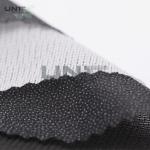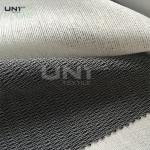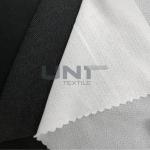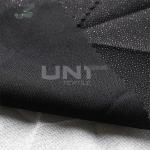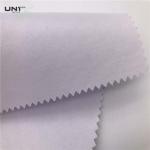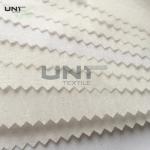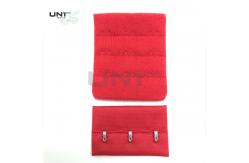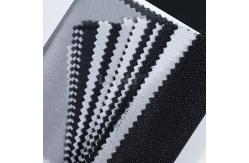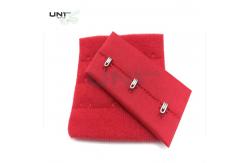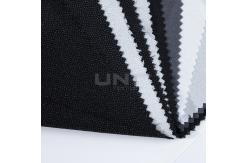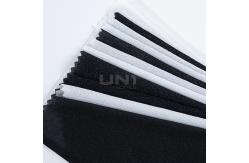Fusible interlining is a type of fabric used in garment manufacturing to add
structure, reinforcement, and support to fabrics. It is a specially
treated material with an adhesive coating on one side that allows
it to bond with other fabrics when heat and pressure are applied.
Fusible interlining is widely used in various garment types, such
as shirts, jackets, collars, cuffs, and waistbands, providing them
with enhanced shape, firmness, and stability. Manufacturing Process of Fusible InterliningThe production of fusible interlining typically involves the
following steps: Fabric Selection: The base fabric, which can be woven or nonwoven, is chosen
depending on the specific requirements of the garment. Common
materials include cotton, polyester, or nylon. Adhesive Coating: A thermoplastic adhesive, typically in the form of powder or
film, is applied to one side of the fabric. This adhesive is the
key to the fusible property, allowing the interlining to bond with
the main fabric when heated. Heat Treatment: The fabric is subjected to a heat treatment process that ensures
the adhesive is evenly distributed and activated. This step ensures
that the interlining maintains its fusible properties during
garment production. Finishing: The fusible interlining is finished to achieve the desired
characteristics such as softness, flexibility, and strength. This
may include additional processes like calendaring, which smooths
the fabric, or steaming to enhance the adhesive's effectiveness.
Key Features of Fusible InterliningStrong Adhesion: The adhesive layer enables fusible interlining to bond firmly to
the fabric, providing long-lasting support and structure. Easy Application: Fusible interlining is easy to apply by simply using heat and
pressure, typically with an iron or pressing machine. This
convenience makes it ideal for large-scale garment production. Enhanced Durability: The fusible nature ensures that the interlining stays in place
even after multiple washes and wear, maintaining its integrity and
performance over time. Versatility: Fusible interlining comes in various weights, thicknesses, and
finishes, making it suitable for a wide range of garment types,
from lightweight blouses to heavy outerwear. Improved Shape and Structure: Fusible interlining helps maintain the desired shape of garments,
preventing sagging, wrinkling, or stretching, which improves the
overall appearance and longevity of the clothing. Comfort and Softness: Despite providing structure, fusible interlining remains soft and
flexible, ensuring that it does not compromise the comfort of the
garment.
Types of Fusible InterliningWoven Fusible Interlining: Made from woven fabrics, this type of fusible interlining offers
high stability and strength. It is often used for applications
where a crisp, structured finish is required, such as in shirts,
collars, and cuffs. Nonwoven Fusible Interlining: Produced from fibers that are bonded together, nonwoven fusible
interlining is more flexible and lightweight. It is ideal for use
in garments that require softness and drape, such as in dresses or
skirts. Lightweight Fusible Interlining: This type of interlining is thinner and more flexible, providing
a softer feel while still offering structure. It is typically used
in delicate fabrics that need minimal reinforcement. Heavyweight Fusible Interlining: Suitable for more rigid garments, this type of interlining
provides substantial structure and support. It is often used in
outerwear, jackets, and coats. Stretch Fusible Interlining: Stretch fusible interlining has the added advantage of
elasticity, making it suitable for knitwear or fabrics with a
stretch component. It allows the garment to retain its shape
without compromising the stretchability of the fabric.
Applications of Fusible InterliningShirts: Fusible interlining is commonly used in shirts, especially in
collars, cuffs, and plackets, to provide crispness and structure. Jackets and Coats: It is widely used in outerwear to add stability to areas like
lapels, waistbands, and the front panels, ensuring that the garment
maintains its shape. Skirts and Dresses: Fusible interlining helps in maintaining the shape of skirts,
dresses, and other structured garments while ensuring that the
fabric remains soft and comfortable. Trousers: In trousers, fusible interlining is often used in waistbands and
pockets to provide extra strength and support. Accessories: Fusible interlining is also used in the production of accessories
such as bags, belts, and hats, where added structure is required. Home Textiles: Fusible interlining is used in home textile products like
curtains, upholstery, and cushions to enhance the fabric's
durability and appearance.
Advantages of Fusible InterliningEasy to Apply: Fusible interlining eliminates the need for sewing or stitching,
simplifying the production process and saving time and labor costs. Durability: The adhesive bond created by fusible interlining ensures that it
stays in place throughout the garment's lifecycle, even after
frequent washing. Variety: Fusible interlining comes in different types, weights, and
finishes, giving manufacturers the flexibility to choose the most
suitable option for each garment or product. Improved Appearance: Fusible interlining improves the overall look of the garment by
preventing it from sagging or losing shape, giving it a crisp,
professional finish. Cost-Effective: The application of fusible interlining can reduce the need for
more expensive construction methods or additional layers of fabric,
making it a cost-effective choice for manufacturers.
ConclusionFusible interlining is a versatile and essential material in garment manufacturing,
offering support, shape, and durability to various types of
fabrics. Whether used in shirts, coats, or skirts, fusible
interlining provides a simple and efficient way to enhance the
structure and longevity of garments. At Shanghai Uneed Textile Co., Ltd., we offer high-quality fusible interlining in a variety of types,
weights, and finishes to meet the needs of different industries.
Our products are designed to ensure easy application, durability,
and superior performance, making them the perfect choice for your
garment production needs |
